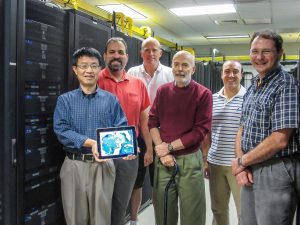Study Evaluates Ocean Current Prediction Models
– July 25, 2014
Scientists with the Naval Research Laboratory (NRL) at Stennis Space Center in Mississippi compared the accuracy and reliability of real-time ocean modeling forecast systems for near-surface currents.
They examined models that combine many separate forecasts to produce ocean state uncertainties (ensembles) and models that produce single forecasts. The ensembles provided not only more accurate predictions of currents than the single forecast models but also the valuable corresponding forecast uncertainties especially when calibrated. The ensemble models also improved predictions of particle trajectories and computations of Lagrangian Coherent Structures (LCSs) that play an important role in directing near-surface currents (as happened after the Deepwater Horizon oil spill, causing a “Tiger Tail” of oil dispersion as described by Olascoaga and Haller in PNAS).
The NRL team published their results in the September 2013 on-line issue of Deep Sea Research II: Topical Studies in Oceanography: The performance of the US Navy’s RELO ensemble, NCOM, HYCOM during the period of GLAD at-sea experiment in the Gulf of Mexico.
During the summer of 2012, NRL scientists used both ensemble and single forecast systems to provide modeling and data assimilation in support of the CARTHEGrand Lagrangian Deployment (GLAD) experiment, an effort that measured transport and dispersion processes at spatial scales as small as 100 meters. The purpose of the GLAD experiment was to improve understanding of how pollutants travel on the ocean’s surface for better response efforts to future contaminations. Prior to and during the deployment of the 317 CARTHE drifters near the Deepwater Horizon site, the NRL team produced real-time ocean forecasts that included in-situ and satellite observations processed at the U.S. Naval Oceanographic Office. Scientists evaluated the forecast results in six-hour cycles, finding that they provided real-time guidance to the CARTHE team, contributing to the successful execution of the GLAD experiment.
In this study, the team examined the forecast systems used for the GLAD experiment: RELO (Relocatable Circulation Prediction System) ensembles and single models that use the NCOM (Navy Coastal Ocean Model) and HYCOM (Hybrid Coordinate Ocean Model) with different resolutions. They conducted a comprehensive evaluation of these systems’ performance and efficiency, verifying them against the Navy’s operational observations. They detailed the advantages and disadvantages of the different models, using verification metrics of the root-mean-square error, anomaly correlation, spread-reliability, and Talagrand rank histogram.
When compared to single ocean model forecasts, the calibrated ensemble was found to be superior to the un-calibrated ensemble in terms of quantitative forecasting accuracy, skill, and reliability for all the variables and observation spaces. Additionally, ensembles generated important uncertainty information that increased the accuracy of particle trajectory predictions than did the single ocean model forecasts, and the calibrated ensemble successfully predicted trajectories that were often missed by the un-calibrated ensemble. The calibrated ensemble also improved estimations of LCSs in the Gulf of Mexico.
The researchers acknowledged that the RELO ensemble underestimates dispersion but that improved accounting for model-related uncertainties will further increase the reliability of RELO ensembles. They also noted that their work using ocean ensembles in Lagrangian ocean dynamics “represents our initial attempt in this field.” However, they do expect that scientists will use both the GLAD drifter data sets and the NRL real-time forecasts to conduct more extensive research in this area.
The authors for this study are Mozheng Wei, Gregg Jacobs, Clark Rowley, Charlie N. Barron, Pat Hogan, Peter Spence, Ole Martin Smedstad, Paul Martin, Philip Muscarella, and Emanuel Coelho.
These authors also published another study that focused more specifically on the calibrated RELO ensemble model and its accuracy predicting Lagrangian dynamics in the September 2013 issue of Nonlinear Processes in Geophysics: The impact of initial spread calibration on the RELO ensemble and its application to Lagrangian dynamics.
************
This research was made possible in part by grants from BP/The Gulf of Mexico Research Initiative (GoMRI) to the Consortium for Advanced Research on Transport of Hydrocarbon in the Environment (CARTHE). Other funding sources included PRACTICE 6.2 project at Naval Research Laboratory and supported by the Office of Naval Research (Program Element 0602435N).
The GoMRI is a 10-year independent research program established to study the effect, and the potential associated impact, of hydrocarbon releases on the environment and public health, as well as to develop improved spill mitigation, oil detection, characterization and remediation technologies. An independent and academic 20-member Research Board makes the funding and research direction decisions to ensure the intellectual quality, effectiveness and academic independence of the GoMRI research. All research data, findings and publications will be made publicly available. The program was established through a $500 million financial commitment from BP. For more information, visit https://gulfresearchinitiative.org/.
© Copyright 2010- 2017 Gulf of Mexico Research Initiative (GoMRI) – All Rights Reserved. Redistribution is encouraged with acknowledgement to the Gulf of Mexico Research Initiative (GoMRI). Please credit images and/or videos as done in each article. Questions? Contact web-content editor Nilde “Maggie” Dannreuther, Northern Gulf Institute, Mississippi State University (maggied@ngi.msstate.edu).






